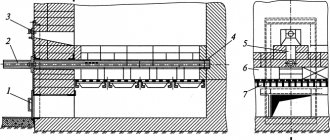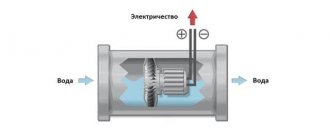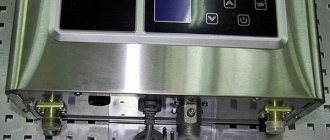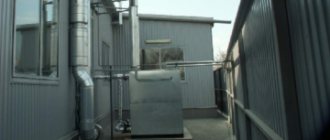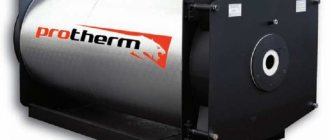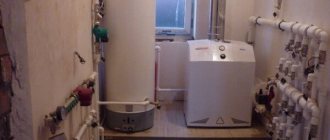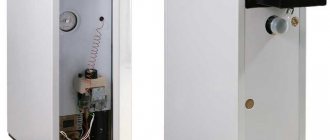Design and principle of operation of a gas water heater
Now let's look at the design and operating principle of a gas water heater. Surely many who lived in Soviet times remember the water pumps of those years, lit by matches and heating water for a long time
They required special attention, strict adherence to the technology of switching on and off, and caution when using - one wrong step and the column “boils”. If your ideas about speakers are exactly like this, then any modern model will seem like a miracle of technology to you.
Modern water heaters supply hot water almost immediately after opening the tap, they turn on automatically or by simply pressing a button, they can regulate the temperature independently, and there are practically no malfunctions in their operation.
The design of the gas water heater has remained virtually unchanged over time, as has the principle of its operation. Gas and cold water are supplied to it through two pipes, and the third pipe at the outlet supplies heated water to the taps. Two burners (pilot and main), a heat exchanger, and a chimney are mounted in the column casing. When the hot water tap in the casing is opened, the valve responsible for the gas supply is activated, and the pilot burner is ignited according to the principle of a lighter and ignites the main burner. The heat from the combustion gas heats the heat exchanger tube through which water passes and combustion products are removed through the chimney. Built-in automation controls the operation of all system elements, which greatly simplifies operation.
Gas water heater without a chimney: how to choose and operate correctly
The presence of heated water in a house or apartment has become the norm for people. The only question is which device will be most effective for heating water for apartments in urban areas or houses located outside the city.
A gas water heater without a chimney must be easy to use and meet the heated water needs of all residents who will use it.
In some cases, a gas water heater with a storage system will be an effective option, while in others, instantaneous water heaters will work great.
Geyser without chimney
A practical and convenient solution, especially for apartments located in multi-storey buildings, would be a gas heater that runs on gas and does not require a chimney pipe - it is also often called turbocharged.
Installation of a chimneyless gas water heater
Such a column works due to the released energy of combustion gas, which heats the water, and does not require the construction of an additional chimney. It can use natural or liquefied gas from the in-house network or from cylinders.
General diagram of the speaker device
Such a column does not require the usual vertical chimney pipe - it differs in the principle of removing combustion products.
The combustion chamber of this water heating device is hermetically sealed, and to allow the gases to escape, a coaxial type of chimney is installed, which is immediately discharged through the wall to the street.
A hole is made in one of the walls immediately when installing a chimneyless column. A special fan is built into the column, which directs combustion products in the desired direction.
Approximate diagram of combustion product output
The coaxial pipe is designed in such a way that exhaust gases are discharged outside through its internal part, and clean air necessary for the combustion process is supplied through the external channel.
Coaxial flue pipe
The convenience of such a device also lies in the fact that the column does not dry out the air in the room, and it does not require additional air flow to support combustion. Due to the fact that there is no need to make a separate vertical chimney, there is the possibility of significant monetary savings on the purchase of materials and installation work.
Video review - the device of a modern geyser
Selena SE 3 can also run on propane, but to do this you need to spend a little more money and equip the dispenser with special technical devices that will make it “omnivorous” and especially unpretentious to the quality of gas!
Water heater parameters
Approximate diagram of the operation of a gas water heater
When choosing a chimneyless water heater, you need to take into account some characteristics, such as power, performance of the device, level of safety, types of ignition and types of burners. The point of horizontal or vertical placement of the device is also important, since combustion product removal systems are arranged differently in the columns.
Power
Its performance will depend on the correctly selected power of the water heater. Power can easily be called the main parameter that needs to be taken into account when purchasing a water heater. A high power level makes it possible to obtain a larger volume of water heated in flow-through heating mode.
Performance
The packaging or instructions for use must indicate the performance of the device, i.e. the volume of hot water produced by an instantaneous water heater per minute of operation, taking into account a certain rise in water temperature.
For example, the instructions indicate that by setting the temperature to 25 degrees, the consumer will receive 14 liters of hot water in one minute. If at the entrance to the heating column the water has a temperature of 8 degrees, then it rises by another 25 degrees due to the operation of the device, i.e. at the exit it will be warmed to 33 degrees.
If you wish, you can make the calculation yourself - to do this, the power indicated by the manufacturer is divided by two. The result of a fairly accurate calculation will be the amount of water produced by the column, heated by 26-32 degrees. For example, a water heater designed to supply 14 liters per minute will have a power of 28-30 kW.
When choosing a water heating device, you need to take into account that for taking a shower, washing your face or washing dishes, 5.5 - 6 liters, dispensed in one minute for each used water sampling point, is quite enough.
Ignition of a chimneyless water heater
On modern water heaters that operate without a traditional chimney, three types of ignition systems are installed - piezo ignition, electric ignition and hydroturbine ignition. They ensure ease of use of the column and its safety.
- Hydroturbine ignition occurs from a hydrodynamic generator. Some modern gas water heaters are equipped with mini-hydroelectric power plants, the generator of which is built into the water heater piping. When water is supplied, it passes through the turbine, rotates its blades, and the generator generates the required electrical potential for the igniter. These water heaters do not require additional energy sources for ignition.
- Piezo ignition has a special element that produces electrical potential from mechanical action, which produces a spark that ignites the burner. With such ignition, there is one inconvenience that will not allow you to save on gas fuel - the igniter must be in a burning state in advance so that when the water is turned on, the main burner will light up.
- Electric ignition requires connecting the column to an electrical outlet or installing batteries (batteries or accumulators). The water pressure sensor is triggered when the tap is opened and gives the command to ignite the igniter due to the spark gap.
What else to look for when choosing
There are a few more lines in the technical characteristics of geysers that are worth paying attention to. First, look at the minimum water and gas pressure that this model can work with
Imported gas water heaters from European manufacturers are more capricious in this regard - they are designed for stable pressure and do not tolerate changes well. But under normal conditions they work stably and without breakdowns.
Some manufacturers, in order to adapt their equipment to our conditions, install gearboxes that compensate for surges. If the model you like does not have such a device, and your water and/or gas pressure fluctuates, you can install the reducer in front of the entrance to the dispenser. This device is simply placed into a pipe break; installation is standard. At the same time, your other consumers will be protected.
Operating parameters must be monitored
It is also useful to review the list of utility programs and protection levels. The safety and comfort of equipment operation depends on them. It is highly desirable to have the following functionality:
- Gas control. Monitors the presence of a flame on the burner; if it goes out, it shuts off the gas supply.
- Traction control. The presence of draft in the chimney is controlled. If combustion products are not removed, the gas supply is shut off.
- Flow control or hydraulic valve. Turns off the column if the water pressure is too weak or there is none at all.
- Overheat protection. The temperature sensor monitors the temperature of the water in the heat exchanger; when it approaches a critical point (boiling), it turns off the column. This extends the service life of the equipment (if it boils, the heat exchanger can rupture, as can the pipes).
These functions are necessary for the safe operation of the geyser. This is almost a standard set that is found in all good gas water heaters. All others are optional. They, as a rule, are no longer so critical (for example, the remote control).
Most popular models
The best geyser is a device that is praised not by sellers and the manufacturer, but by consumers
Therefore, before purchasing a gas instantaneous water heater, we strongly recommend reading reviews and paying attention to the most popular models. Let's see which speakers buyers are most often interested in
Geyser Neva 4511
This column from the Russian company Neva received fairly high user ratings. The device has a capacity of 11 l/min and a power of 21 kW. The column is equipped with an open combustion chamber, an electric ignition system, power-on and heating indicators, and a thermometer. Gas control is also provided. For its operation, the column requires batteries, which power the ignition system. The design of the device is very simple, and the price will please every buyer.
The water heater has received many user reviews, both positive and negative. The number of positive reviews exceeds the number of negative reviews, which is already a big plus. Among the advantages we can include the undoubted simplicity of the model, ease of temperature adjustment and the presence of a thermometer. The downsides are a rather weak heat exchanger and poor performance at low water pressure. But overall, this is a decent device from the budget segment.
Geyser Electrolux GWH 265 ERN Nano Plus
This is one of the best geysers from a renowned manufacturer. Her reviews are mostly positive - we can safely regard her as the optimal choice. Buyers praise the device for its stable operation at low water pressure and ease of settings. Users also note the presence of such a useful option as monitoring the battery status. The appearance of the device is also pleasing - it is immediately clear that this is a completely modern gas instantaneous water heater.
The Electrolux GWH 265 ERN Nano Plus dispenser has a power of 20 kW and a capacity of 10 l/min. It is equipped with an open combustion chamber, a pleasant control panel with an informative display, a thermometer, and numerous security systems. Support of heating temperature at a given level is also implemented. The ignition system is electric, runs on batteries. The minimum inlet pressure is 0.15 atm.
Geyser Bosch WR 10-2P
The best geyser from Bosch according to users. In any case, she is very popular. If we compare it with other models, we can note the efficiency of the device - with a productivity of 10 l/min, its power is 17.4 kW. There is no electric ignition here, but there is a simple piezoelectric ignition. It lights the burner instantly, saving users from loud bangs when the batteries are dead. There is no flame modulation on board, so households will have to periodically adjust the heating temperature.
Reviews about the device are mostly positive - more than 70%. Therefore, it is not surprising that the column has gained such high popularity. It is difficult to identify critical failures, since there are very few of them. Positive features include reliable starting at low water pressure and automatic temperature maintenance.
Important points of operation
Gas water heaters have positive and negative qualities.
The positive ones include:
- Can be used in homes where the use of gas equipment was not initially provided.
- Exhaust-free column - no additional exhaust; conventional supply and exhaust ventilation is sufficient.
- High work efficiency.
- Due to the fact that the combustion chamber is isolated, the oxygen present in the room is not burned.
- Since the combustion process occurs in a closed environment, foreign odors, fumes and exhaust gases do not penetrate into the room.
Along with its advantages, the column also has a number of disadvantages:
- High cost of equipment.
- Labor-intensive and expensive installation and connection process.
- The presence of an electric motor requires a power supply network and leads to additional energy consumption.
- During operation, the electric motor driving the fan blades produces a lot of noise.
- The coaxial chimney exits from the opposite side of the building. This may cause additional difficulties with approval bodies.
- The need to coordinate the installation of equipment with neighbors above.
The main reasons why the Oasis speaker does not light up
Sometimes consumers wonder why the Oasis chimneyless gas water heater does not turn on. The cause of this malfunction may be several factors. The first thing you need to check is whether the pipes are installed correctly. The water heater has a special design that will not work if the outlet and inlet pipes are connected incorrectly.
The most common and common reason for a geyser to fail to work is the lack of traction. If clogging occurs with foreign objects or dust, the burner will simply go out. The protection system will work and shut off the fuel supply. If the column still lights up, but goes out after a while, then the reason for this may be a sensitive protective relay. When the windows are closed, the relay overheats and its protection is activated. In this case, you need to open the window or windows. This measure is temporary, because in this case the relay needs to be replaced.
Main characteristics of the speakers
Now let's talk about the practical aspects of using the speaker. One of the main characteristics is performance. It directly correlates with power, which is indicated in kW and shows the volume of water heated per minute by 25 °C.
The characteristics are usually indicated in the device passport. A regular water heater heats 10-20 liters of water per minute at 25 °C, although this value can vary significantly.
Another characteristic of modern speakers is power modulation. It shows how the power of the column can change depending on the flow of water and is measured as a percentage of the initial power.
For modulation, the columns are equipped with special fittings with a membrane, which changes the gas supply to the burner depending on the flow. Modulation in the range of 40-100% of the device power is considered normal.
The diagram shows the modulating valve and the principle of its operation, which is similar to the operation of a water unit and its membrane
How to determine power
First of all, you need to decide on the power or performance of the gas water heater. These are two interrelated characteristics that simply reflect different characteristics of the unit. Performance is how many liters of water a column can heat per minute, and power is how much heat it can release. Some manufacturers indicate power, others indicate performance, so you need to understand exactly what you need.
Let's first figure out what kind of performance you need from your geyser. This depends on the number of consumers who need to be provided with warm water. There are consumption standards for different types of equipment:
- kitchen sink, washbasin - 4 l/min;
- shower - 7-10 l/min.
If you have a kitchen sink, shower and washbasin connected to hot water, so that all three points work simultaneously and the water temperature does not drop, you need a capacity of 4 + 4 + 10 = 18 l/min. This is a lot, the price tag will be substantial. If you think about it, you will realize that all three devices are almost never turned on at the same time. There are situations when the shower and one of the taps work together. To provide them with hot water, the capacity must be 14 l/min. This is a little more modest, but quite enough for a comfortable stay. Look for the found value in the technical specifications; it should not be less.
Now let's look at power. Gas water heaters can allocate from 6 kW to 40 kW of heat for heating water. Here the division is:
- a gas water heater with a capacity of up to 19 kW is suitable for heating water for one water collection point;
- for two points the power should be from 20 kW to 28 kW;
- three require more than 29 kW.
Now, you can definitely say which geyser is better in terms of power in relation to your needs.
Power and performance
Correctly selected power affects the performance of the device. It is the main parameter of a geyser , which must be taken into account when choosing a water heater.
The high power level provides a much larger volume of water heated in instantaneous heating mode. The instructions for the device must indicate its performance , that is, the volume of hot water that the instantaneous water heater produces in one minute of operation, taking into account the increase in water temperature.
For example, at a temperature of 25 degrees specified in the instructions, the consumer can receive 14 liters of hot water in one minute. If the water temperature at the entrance to the gas water heater is 8 degrees, then thanks to the operation of the device it rises by another 25 degrees and at the outlet it will be warmed to 33 degrees.
The main advantages of the Grandini JSQ24-C speaker
The chimneyless gas water heater Grandini JSQ24 C is equipment that is made in the best Italian traditions. The device is able to heat water in the shortest possible time, providing the consumer with the required amount. The design has a modern design and compact dimensions.
Installation is quite simple. Water supply will be provided in a volume of 8 liters per minute. This setting is minimal. When the temperature drops, it can be increased to 12 liters per minute. The power of the equipment is 24 kW. The column operates in automatic mode, and ignition is carried out from batteries.
Pros of the geyser Vector JSD 11 N
This chimneyless geyser “Vector” costs 4,900 rubles. Electric ignition is provided by batteries. The productivity is slightly lower compared to other devices and is 5 liters of water per minute. The case has compact dimensions.
The minimum water pressure is 0.2 atmospheres. Additional advantages include the presence of a copper heat exchanger, which is treated with an anti-corrosion coating during the production process. The system has gas control and overheating protection. The protection is also triggered when there is no sufficient draft level in the chimney.
Useful tips to ensure long and reliable operation of geysers
- Installation and connection must be carried out by qualified specialists. Often the quality of its operation depends on how the gas water heater is configured.
- It is necessary to regularly clean the igniter and heat exchanger from combustion products (it is strange to blame the column for blockages). This will significantly extend the “lifespan” of the device.
- In old houses with too low water pressure in the system, it is better to install special pumps. With stable water pressure, automatic start-up occurs without problems, and the heating temperature will be maintained more correctly.
- Important recommendations from the manufacturer as stated in the user manual must be followed.
Excellent performance at average consumption. High heating rate. The automation works excellently: the speaker turns itself on and off without delays or false alarms. Starts working even with the slightest trickle of water.
The speaker is volatile; it will not work without a constant connection to the power supply. Use in areas with water supply problems will be extremely inconvenient. Another nuance is that as the pressure drops, the water temperature rises.
A little noisy, but over time you can get used to it. Quite demanding, she needs careful care. Once every one and a half to two years, it is necessary to clean the channels from scale so that the column continues to function properly. This way the user will protect himself from fire or explosion.
Ariston FAST CF 11P
Quite an economical column with high efficiency. It consumes little gas and produces consistently hot water. Works well with low pressure, low pressure. The company has done a good job on user safety, using several technologies for protection. If there is no fire, the gas supply stops. The heater operates on both natural and liquefied gas. The instantaneous gas water heater without a chimney is designed in such a way as to minimize heat loss, increasing the efficiency of heating water. Despite the truly excellent, stable performance, there is a big fly in the ointment that the manufacturer slips in. You cannot find replacement parts from Ariston, and there are no replacement parts. When an element fails, you have to search for a long time for a technician who understands a specific mechanism, along with consumables.
Ariston Marco Polo Gi7S
The gas instantaneous water heater without a chimney Ariston Marco Polo Gi7S is in the most popular price segment. This is where most people look for a solution for their home. The model turned out to be surprisingly successful: low noise level, good response even to a thin stream of water.
In terms of price-quality ratio, this heater occupies one of the leading positions. The model has introduced excellent trends of recent years: touch control, power adjustment, temperature control. The protection and safety system is at a high level, including an electronic anti-freeze system.
Operates on liquefied or natural gas, delivering the same efficiency.
| type of instalation | Wall |
| Installation method | Vertical |
| Combustion chamber type | Closed |
| Ignition type | |
| Power | |
| Gas consumption | Natural 2.2 m 3 /h Liquefied 0.79 m 3 /h |
| Performance | |
| Peculiarities | Anti-blowing valve Autodiagnosis |
| Rating (0-5) |
Ariston is a company that has something to offer even the most demanding client. The range includes ultra-budget gas instantaneous water heaters without a chimney, expensive and premium ones. They differ in design and technology used. The numbers and characteristics may be similar, but in everyday use, underground problems appear, such as unstable operation. Ariston Marco Polo M2 is the most common model that is in demand among users. It has a low cost, and at the same time shows good performance. For its price it is a good model, although it is not without its shortcomings. Gas water heaters without a closed chimney are a separate type of device, and the manufacturer has excellent examples in this class. Ariston Marco Polo Gi7S has an average cost and high efficiency, thanks to which it has gained popularity. This water heater definitely takes the lead in the TOP. Second place - Ariston Marco Polo M2. Ariston FAST CF 11P receives honorary bronze due to problems with replacement parts; reviews of the column are not the most positive.
General structure of a household water heater
A geyser is a flow-through water heating device. This means that water passes through it and heats up as it goes. But, before moving on to an analysis of how a household gas water heater works, let us recall that its installation and replacement are associated with a centralized gas supply system.
Therefore, you must submit documents to the gas service of your region along with the appropriate application. You can read about the norms and necessary documents in our other articles, but now let’s move on to the device.
Different models of geysers differ from each other, but the general structure of a household geyser looks something like this:
- Gas-burner.
- Igniter/ignition system.
- Exhaust hood and connection to the chimney.
- Chimney pipe.
- The combustion chamber.
- Fan (on some models).
- Heat exchanger.
- Gas supply pipe.
- Water node.
- Connections for water supply.
- Pipe for hot water outlet.
- Front panel with controller.
The central element of the column is a gas burner, in which gas combustion is maintained, which helps to heat the water. The burner is installed in a housing; hot combustion products are collected in it, the purpose of which is to heat water.
The housing is made of metal and completely covers the front and sides of the speaker
It is important that the material of the housing conducts heat well, because the quality of heating depends on the transmission of heat.
Structural components of a geyser located inside the housing. Closed type gas equipment is shown here
On top of the device there is an exhaust hood and a chimney through which combustion products leave the column and the room. Their design depends on whether the column is open or closed, which will be shown below.
The pipes meander like a coil inside the body, water passes through them under natural pressure and is warmed by hot gases. This entire pipe system is called a heat exchanger. At the bottom there are two pipes: on the right - for receiving cold water from the pipeline, on the left side hot water flows out.
A filter is often installed between the water supply network and the gas water heater, which regulates the water hardness. Without a filter, the column may become covered with scale at high water temperatures. When entering the column, water passes through a water unit, which serves as a kind of “connection” between the water flow and the gas flow. We'll talk about this connection a little further.
Burning gas burner with electric ignition and flame sensor. Sensors play an important role in the functioning of equipment. We'll talk about their functions further.
Using another tube, which is also located below, the column is connected to the gas main.
There is also a front panel with a control unit. It is equipped with regulators to control gas and water consumption. Depending on the model, these can be either simple knobs that need to be turned, or liquid crystal displays, where you can see many characteristics of the column, or even the nature of its malfunction if the column does not work.
Advantages and disadvantages of turbocharged speakers
Pros:
- Installation does not require a traditional chimney.
- Forced air injection increases the efficiency of the device.
- The operation of the column does not increase the temperature in the kitchen (or other room where it is installed), which is especially pleasant in the summer.
- The combustion air comes from the outside - there is no problem of absorbing internal air.
- The closed body of the device reduces the risk of combustion products entering the living space.
Minuses:
- Any chimneyless water heater is connected to the mains. Her energy dependence creates problems when the lights go out - she simply cannot function.
- The turbine pumping air creates noise.
- Prices for water heaters with a closed combustion chamber are higher than for traditional modifications. The average model costs about 15,000 - 17,000 rubles. There are also more expensive versions.
- The installation of a water heater without a chimney must be agreed upon with the organization supplying natural gas. The owner of such equipment is also obliged to obtain consent from neighbors above. Problems may arise with the architectural control service if it is necessary to install a pipe on the facade of the building.
- Condensation constantly forms in the pipe connecting the device to the street; in winter, this can lead to freezing.
How to use
This gas water heater is automatic and easy to use. But you still need to study the instructions for use. First of all, you need to install it correctly. Such water heaters are connected not only to the water supply system, but also to gas pipes. This should be done by a specialist. Additionally, you will have to purchase a chimney pipe, fittings, and fasteners.
After installing the device and connecting to all communications, the specialist will make preliminary settings for the device and check its operation. The operating instructions recommend first passing water through the column pipes, removing air from them. Then close the tap and insert the batteries. Now, after turning on the water tap, the burner will automatically ignite. All that remains is to set the desired temperature. It is recommended to choose no more than 550, especially if the water hardness is increased.
During operation of this water heater, various malfunctions may occur. Most often, users contact the service center about several problems.
The Vector water heater does not turn on or lights up and immediately goes out. There may be several reasons for this problem. The most common is that the batteries are dead. You can handle this on your own. But if there is a spark, but the “Vector” column does not light up, you need to check the traction. The chimney may be clogged or the seal of the air duct joint may be broken.
The water doesn't heat up well. This most often happens due to scale accumulation or clogged heat exchanger tubes. But you may have to study again how to adjust the power.
Poor water pressure from the boiler when the water supply is normal may be due to a clogged heat exchanger or water filter.
The speaker makes a lot of noise when working. The reason for this may be a malfunction of the heat exchanger or very high gas pressure.
The question of how to disassemble and repair a water heater is best left to specialists. But some problems at work can be solved on your own. For example, if the filter or heat exchanger tubes become clogged, they can be removed and washed under water. "Vector" is a water heater for which it is easy to buy parts. But with regular descaling and proper operation, the device will last a long time without repair.
Turning on the device
The first step is to install the batteries. To do this, open the battery compartment and install them, observing the polarity. Then you need to open the cold water and gas valves. Open the hot liquid tap on the nearest faucet.
At the moment when the liquid flows through the water unit, a spark ignition occurs and, thanks to this, the burner ignites. If it is turned on for the first time or after a long period of inactivity, air may accumulate in the gas line; in order to remove it, you will need to open the mixer several times, hold it for a minute, and then close it.
Features of gas water heaters with turbocharging
Let us note right away that units of this type still have a chimney. The term “chimneyless boiler” is used in the sense that a gas-using installation does not require a traditional chimney with natural draft. This is one of the many features that distinguish gas water heaters with a closed combustion chamber. Natural draft is not needed, because the device has its own forced draft, provided by a fan. And a special double-walled (coaxial) chimney is used to supply air and exhaust exhaust gases.
Now let’s collect all the technical solutions implemented in a turbocharged water heater into one list, and then consider each of them separately:
- automatic ignition system using electricity;
- forced removal of flue gases and intake of combustion air from the outside using a turbine;
- sealed, closed combustion chamber;
- modulation burner;
- electronic control unit;
- a system that prevents the heat exchanger from defrosting.
Since turbocharged gas water heaters are always connected to the house electrical network, they use an electric ignition system. On many Internet resources you can find information that supercharged units use piezoelectric ignition or sparking from batteries. This data does not correspond to reality; there is no point in integrating batteries into a device connected to a 220 V network. Not to mention manual piezo ignition, which is absolutely incompatible with the operation of automation equipment.
A fan installed in a turbocharged gas water heater performs 2 tasks: it pushes combustion products into the coaxial chimney and draws air from the street into the chamber, bypassing the room. In heater circuits from different manufacturers, the turbine can be implemented in different ways:
- as a blower - the fan is located at the beginning of the gas-air path, in front of the burner and pumps air into the closed chamber;
- as a smoke exhauster - the turbine is located in front of the flue gas outlet, behind the heat exchanger, and operates in suction mode.
The combustion chambers of turbocharged engines are only conditionally sealed. This means that they are separated from the indoor air, but communicate with the street, so there is no significant excess pressure in them. The point is that the fan supplies exactly the amount of air required for combustion in one mode or another. The performance of the blower (or smoke exhauster) is controlled by the controller.
The gas burner of the device operates in tandem with the fan. According to the principle of operation, it is modulating, that is, it is capable of smoothly changing the combustion intensity in automatic mode. In this case, the gas burner device is guided by changes in water pressure that arise as a result of an increase or decrease in water intake.
All processes in the heater from start to finish are controlled by an electronic unit - controller. Based on sensor signals, the latter regulates the burner power and fan performance, and if an emergency occurs, it gives a command to shut off the gas. However, the circuit is designed in such a way that in the event of a serious accident, the gas valve itself will turn off the fuel supply, without a command from the controller.
And the latest innovation is a system that protects the heat exchanger from defrosting when the room temperature drops below 0 ºС. The antifreeze geyser is equipped with a special electric heater that automatically turns on at a temperature of 0 ºC or lower in standby mode when the water in the heat exchanger tubes does not move.
Pros and cons of a chimneyless gas water heater
Gas water heaters operating without a chimney have the following advantages:
- They can be installed in any room. For example, in a new house where the design does not provide for a chimney for a gas water heater. Or in a country house, in a dacha, where there is no specially constructed chimney;
- This device does not dry the indoor air, which is typical for a standard geyser;
- The air in the room does not heat up, which is especially noticeable during hot weather;
- The efficiency of the water heater is increased due to the forced removal of exhaust air. Unlike this type of water heater, in a standard geyser, combustion products are discharged by gravity, through a common pipe;
- The combustion chamber of the column is completely isolated, so no foreign odors characteristic of combustion products appear in the room.
However, this equipment also has certain disadvantages:
- Installing a column of this type is more difficult than a conventional water heater. You need to drill a hole in the wall and then carefully seal it, leaving a special nozzle outside;
- Prices for turbocharged gas pumps are set higher;
- The presence of a fan requires connecting the device to an electrical outlet. If the power goes out, the speaker will be impossible to use;
- Coordination of the installation of gas equipment with the relevant authorities is required, since the fact of the presence of such a column will be impossible to hide;
- A turbocharged column creates an increased noise effect due to a running fan and air flows moving at high speed. This is noticeable both indoors and outdoors;
- Your upstairs neighbors, if there are any, may not like such a device, because the smell of exhaust gases will partially reach them, and it will also be periodically noisy outside the windows.
Exterior view of the coaxial chimney
Advice: Before installing such equipment in a multi-story building, coordinate its installation with your neighbors if you do not want to make enemies.
Heat exchanger
Water is heated while it flows through the heat exchanger. It is a metal pipe installed above the burner. The shape of the heat exchanger in a gas water heater is special - a pipe with fins is laid in a snake at the bottom, then a sheet of metal is installed around it, on top of which the pipe is wound in a spiral. Water flowing through this long path is heated by the heated metal.
This is what a heat exchanger for a gas water heater looks like
Heat exchangers are made from galvanized steel (the most budget option), stainless steel and copper. The best in terms of efficient heat transfer are copper. They are the most economical, but also expensive. The most durable ones are stainless steel, but they are much worse at heat transfer. Which gas water heater is better in this case is up to you to decide. Choose the quality that is more important to you.
If you decide to buy a gas water heater with a copper heat exchanger, do not try to find a cheap model. In order to reduce the price, manufacturers use low-quality copper, and the tubes are also made with thin walls. Such a heat exchanger will serve the warranty period, and then problems will begin - a leak will appear.
If you remove the casing, you will see fistulas in the tubes through which water drips. They are located mostly on the outside of the pipe, exactly in the place where condensation forms. If the pipe is of normal thickness, this is not a problem, but it quickly corrodes thin walls. Such a heat exchanger with a leak does not need to be replaced (it costs about 1/3 of the total price), it can be soldered. You will need refractory solder with a melting point of about 200°C, a powerful soldering iron and soldering flux. The technology of work is usual - clean the damaged area to bare metal, degrease, tin, and solder.
Flue gas removal system for a column without a chimney
Scheme for removing flue gases from a column without a chimney.
Geysers without a chimney use a closed combustion chamber. Exhaust gases are removed and air is supplied using a coaxial chimney (the so-called pipe in a pipe), leaving the room through the wall.
A chimneyless geyser is perfect for rooms that do not have a traditional chimney. In this case, combustion products are removed through a special coaxial chimney, for which it is enough to simply make a hole in the wall. The use of a chimneyless gas water heater will allow the use of various modifications of chimneys when designing. The gas exhaust system can be designed as a horizontal chimney or as a vertical chimney.
